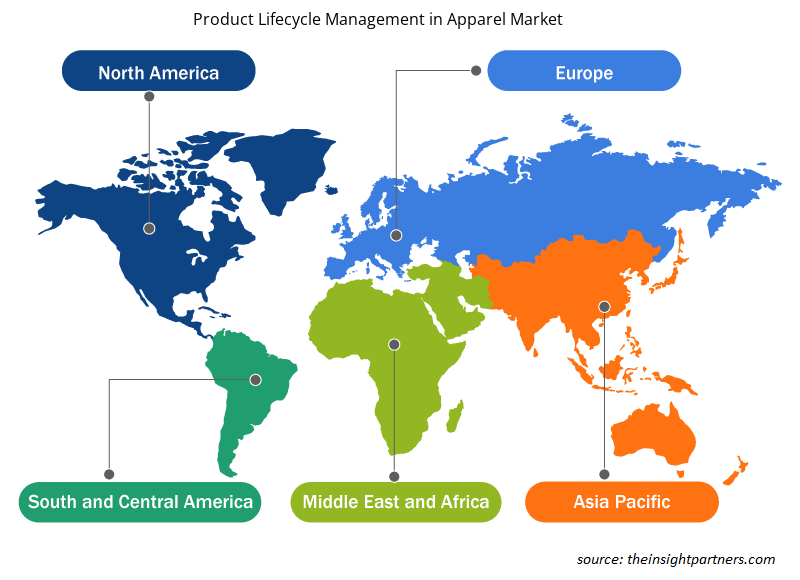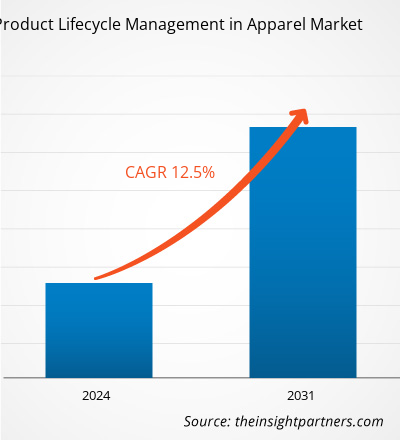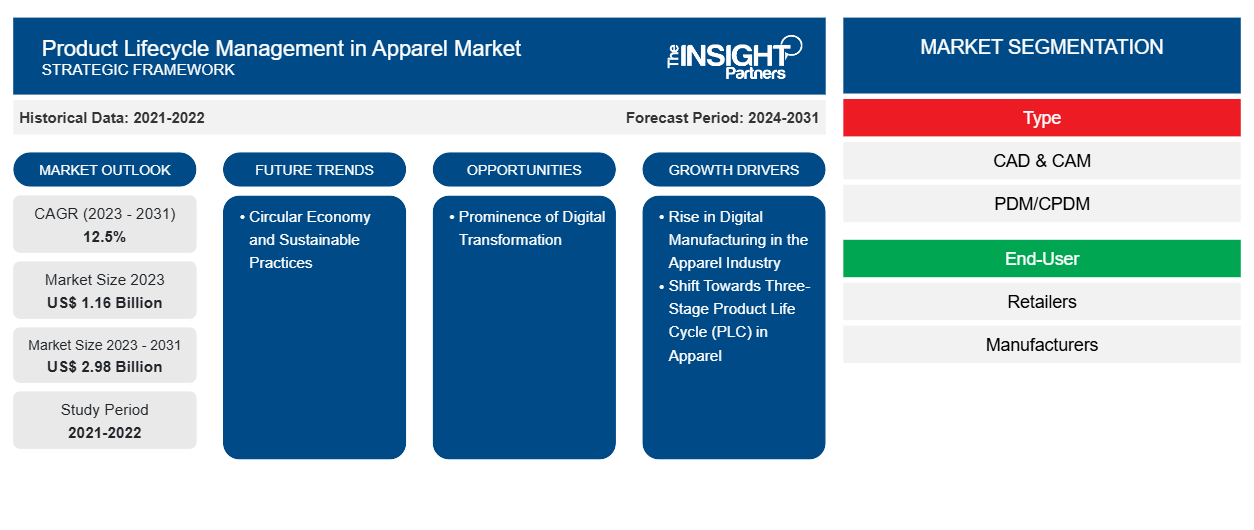Si prevede che la gestione del ciclo di vita del prodotto nel mercato dell'abbigliamento raggiungerà i 2,98 miliardi di dollari entro il 2031, rispetto agli 1,16 miliardi di dollari del 2023. Si prevede che il mercato registrerà un CAGR del 12,5% nel 2023-2031. L'economia circolare, le pratiche sostenibili e l'enfasi sulla trasformazione digitale rimarranno probabilmente le tendenze chiave della gestione del ciclo di vita del prodotto nel mercato dell'abbigliamento.lifecycle management in apparel market size is projected to reach US$ 2.98 billion by 2031 from US$ 1.16 billion in 2023. The market is expected to register a CAGR of 12.5% in 2023–2031. Circular economy & sustainable practices and emphasis on digital transformation are likely to remain key product lifecycle management in apparel market trends.
Analisi del mercato della gestione del ciclo di vita del prodotto nell'abbigliamento
I rapidi cambiamenti nei gusti dei consumatori caratterizzano l'industria della moda e la riduzione della durata di vita dei prodotti, aggiungendosi alla sua complessità. Questi cambiamenti creano difficoltà e prospettive in molteplici aree del settore, come la produzione, i metodi di produzione, gli standard e gli sforzi di pubblicità e marketing.
Panoramica sulla gestione del ciclo di vita del prodotto nel mercato dell'abbigliamento
Nel settore dell'abbigliamento, la gestione del ciclo di vita del prodotto (PLM) è un approccio strategico per supervisionare l'intero percorso di un prodotto, dalla progettazione e sviluppo iniziali al lancio ufficiale, al servizio e allo smaltimento. Questo metodo completo comporta la gestione di tutte le attività correlate al ciclo di vita di un prodotto, come la produzione, il marketing e l'eventuale rimozione dal mercato. Attraverso l'approccio PLM, il settore può analizzare quanto bene un prodotto viene ricevuto dal mercato nel tempo, comprese le fluttuazioni significative nelle vendite.
Personalizza questo report in base alle tue esigenze
Riceverai la personalizzazione gratuita di qualsiasi report, comprese parti di questo report, o analisi a livello nazionale, pacchetto dati Excel, oltre a usufruire di grandi offerte e sconti per start-up e università
-
Scopri le principali tendenze di mercato in questo rapporto.Questo campione GRATUITO includerà analisi di dati che spaziano dalle tendenze di mercato alle stime e alle previsioni.
Gestione del ciclo di vita del prodotto nel mercato dell'abbigliamento: fattori trainanti e opportunità
Aumento della produzione digitale nel settore dell'abbigliamento per dare impulso al mercato
Si prevede che l'ascesa della produzione digitale nel settore dell'abbigliamento avrà un impatto significativo sulla richiesta di sistemi di gestione del ciclo di vita del prodotto (PLM) robusti e affidabili. Ciò è dovuto in gran parte ai complessi processi coinvolti nella produzione digitale, tra cui ideazione, progettazione, pianificazione ed esecuzione, tutti i quali richiedono un uso estensivo di software PLM come CAD e CAM. Di conseguenza, si prevede che l'espansione della produzione digitale aumenterà la necessità di sistemi PLM, guidando così il progresso della gestione del ciclo di vita del prodotto nel mercato dell'abbigliamento nel periodo previsto.
Importanza della trasformazione digitale
Il continuo passaggio alla digitalizzazione ha aperto nuove strade all'innovazione, incorporando tecnologie avanzate come l'apprendimento automatico (ML), l'intelligenza artificiale (AI), la robotica e l'Internet of Things (IoT) per aprire la strada all'era della quarta rivoluzione industriale (Industria 4.0). Nell'Industria 4.0, la fusione di elettronica e tecnologia informatica facilita l'integrazione digitale senza soluzione di continuità degli aspetti fisici, digitali e biologici della vita umana moderna. Ciò segna un cambiamento significativo per l'industria manifatturiera, in particolare nella produzione di beni di massa come abbigliamento e calzature, poiché l'Industria 4.0 innesca una trasformazione rivoluzionaria. digitalization has opened up new avenues for innovation, incorporating advanced technologies such as machine learning (ML), artificial intelligence (AI), robotics, and the Internet of Things (IoT) to lead the way into the era of the fourth industrial revolution (Industry 4.0). In Industry 4.0, the blending of electronics and information technology facilitates the seamless digital integration of the physical, digital, and biological aspects of modern human life. This marks a significant change for the manufacturing industry, particularly in the production of mass-manufactured goods like clothing and footwear, as Industry 4.0 instigates a revolutionary transformation.
Analisi della segmentazione del rapporto di mercato sulla gestione del ciclo di vita del prodotto nell'abbigliamento
I segmenti chiave che hanno contribuito alla derivazione dell'analisi della gestione del ciclo di vita del prodotto nel mercato dell'abbigliamento sono la tipologia e l'utente finale.
- In base al tipo, il mercato è diviso in CAD & CAM e PDM/CPDM. Il segmento CAD & CAM ha detenuto una quota di mercato significativa nel 2023.
- In termini di utenti finali, il mercato è segmentato in rivenditori,produttori e altri. Il segmento dei produttori ha detenuto una quota sostanziale del mercato nel 2023.
Analisi della quota di mercato della gestione del ciclo di vita del prodotto nell'abbigliamento per area geografica
L'ambito geografico del rapporto sulla gestione del ciclo di vita del prodotto nel mercato dell'abbigliamento è suddiviso principalmente in cinque regioni: Nord America, Asia Pacifico, Europa, Medio Oriente e Africa e Sud America/Sud e Centro America.
La gestione del ciclo di vita del prodotto nel mercato dell'abbigliamento in Europa comprende la gestione dell'intero ciclo di vita dei prodotti di moda, affrontando le sfide uniche poste dalle tendenze in rapida evoluzione e dalle preferenze dei consumatori. Si prevede che il mercato sperimenterà una crescita significativa e l'adattamento alle mutevoli dinamiche di mercato presenta opportunità per le aziende nel settore dell'abbigliamento europeo.
Gestione del ciclo di vita del prodotto nel mercato dell'abbigliamento: approfondimenti regionali
Le tendenze regionali e i fattori che influenzano il Product Lifecycle Management nel mercato dell'abbigliamento durante il periodo di previsione sono stati ampiamente spiegati dagli analisti di Insight Partners. Questa sezione discute anche i segmenti e la geografia del Product Lifecycle Management nel mercato dell'abbigliamento in Nord America, Europa, Asia Pacifico, Medio Oriente e Africa e Sud e Centro America.

- Ottieni i dati specifici regionali per la gestione del ciclo di vita del prodotto nel mercato dell'abbigliamento
Ambito del rapporto sulla gestione del ciclo di vita del prodotto nel mercato dell'abbigliamento
| Attributo del report | Dettagli |
|---|---|
| Dimensioni del mercato nel 2023 | 1,16 miliardi di dollari USA |
| Dimensioni del mercato entro il 2031 | 2,98 miliardi di dollari USA |
| CAGR globale (2023-2031) | 12,5% |
| Dati storici | 2021-2022 |
| Periodo di previsione | 2024-2031 |
| Segmenti coperti |
Per tipo
|
| Regioni e Paesi coperti |
America del Nord
|
| Leader di mercato e profili aziendali chiave |
|
Densità degli attori del mercato: comprendere il suo impatto sulle dinamiche aziendali
Il mercato Product Lifecycle Management in Apparel Market sta crescendo rapidamente, spinto dalla crescente domanda degli utenti finali dovuta a fattori quali l'evoluzione delle preferenze dei consumatori, i progressi tecnologici e una maggiore consapevolezza dei vantaggi del prodotto. Con l'aumento della domanda, le aziende stanno ampliando le loro offerte, innovando per soddisfare le esigenze dei consumatori e capitalizzando sulle tendenze emergenti, il che alimenta ulteriormente la crescita del mercato.
La densità degli operatori di mercato si riferisce alla distribuzione di aziende o società che operano in un particolare mercato o settore. Indica quanti concorrenti (operatori di mercato) sono presenti in un dato spazio di mercato in relazione alle sue dimensioni o al valore di mercato totale.
Le principali aziende che operano nella gestione del ciclo di vita del prodotto nel mercato dell'abbigliamento sono:
- Moda C-DESIGN
- Soluzione generata dal computer
- Dassault Systèmes
- EFI Optitex
- Tecnologia Gerber LLC
- Informazioni su Infor Inc.
Disclaimer : le aziende elencate sopra non sono classificate secondo un ordine particolare.

- Ottieni la panoramica dei principali attori chiave del mercato della gestione del ciclo di vita del prodotto nell'abbigliamento
Gestione del ciclo di vita del prodotto nel mercato dell'abbigliamento: notizie e sviluppi recenti
La gestione del ciclo di vita del prodotto nel mercato dell'abbigliamento viene valutata raccogliendo dati qualitativi e quantitativi dopo la ricerca primaria e secondaria, che include importanti pubblicazioni aziendali, dati associativi e database. Di seguito è riportato un elenco degli sviluppi nel mercato:
- Aptean, fornitore globale di soluzioni software aziendali di importanza critica, ha annunciato l'acquisizione di Momentis, fornitore di soluzioni software appositamente progettate per i settori della moda, dell'abbigliamento, delle calzature, del tessile e degli accessori.
(Fonte: Aptean Inc., Comunicato stampa, 2024)
- Infor®, l'azienda di cloud del settore, ha annunciato oggi la disponibilità di un'interfaccia dedicata tra Made2Flow, un'azienda tecnologica specializzata nell'analisi e nella convalida dei dati ambientali nel settore della moda, e Infor product lifecycle management (PLM). L'interfaccia faciliterà l'elaborazione dei dati e la piena visibilità per i marchi di moda globali che cercano di aumentare la trasparenza della supply chain di produzione. Fondamentale, supporterà la tracciabilità e la misurazione dell'impatto tra i livelli da uno a quattro.
(Fonte: Infor, Comunicato stampa, 2023)
Copertura e risultati del rapporto sulla gestione del ciclo di vita del prodotto nel mercato dell'abbigliamento
Il rapporto "Product Lifecycle Management in Apparel Market Size and Forecast (2021–2031)" fornisce un'analisi dettagliata del mercato che copre le seguenti aree:
- Dimensioni e previsioni del mercato a livello globale, regionale e nazionale per tutti i segmenti di mercato chiave coperti dall'ambito
- Dinamiche di mercato come fattori trainanti, vincoli e opportunità chiave
- Principali tendenze future
- Analisi dettagliata delle cinque forze PEST/Porter e SWOT
- Analisi di mercato globale e regionale che copre le principali tendenze di mercato, i principali attori, le normative e gli sviluppi recenti del mercato
- Analisi del panorama industriale e della concorrenza che copre la concentrazione del mercato, l'analisi della mappa di calore, i principali attori e gli sviluppi recenti
- Profili aziendali dettagliati
- Analisi storica (2 anni), anno base, previsione (7 anni) con CAGR
- Analisi PEST e SWOT
- Valore/volume delle dimensioni del mercato - Globale, Regionale, Nazionale
- Industria e panorama competitivo
- Set di dati Excel
Report recenti
Rapporti correlati
Testimonianze
Motivo dell'acquisto
- Processo decisionale informato
- Comprensione delle dinamiche di mercato
- Analisi competitiva
- Analisi dei clienti
- Previsioni di mercato
- Mitigazione del rischio
- Pianificazione strategica
- Giustificazione degli investimenti
- Identificazione dei mercati emergenti
- Miglioramento delle strategie di marketing
- Aumento dell'efficienza operativa
- Allineamento alle tendenze normative























 Ottieni un campione gratuito per - Gestione del ciclo di vita del prodotto nel mercato dell'abbigliamento
Ottieni un campione gratuito per - Gestione del ciclo di vita del prodotto nel mercato dell'abbigliamento